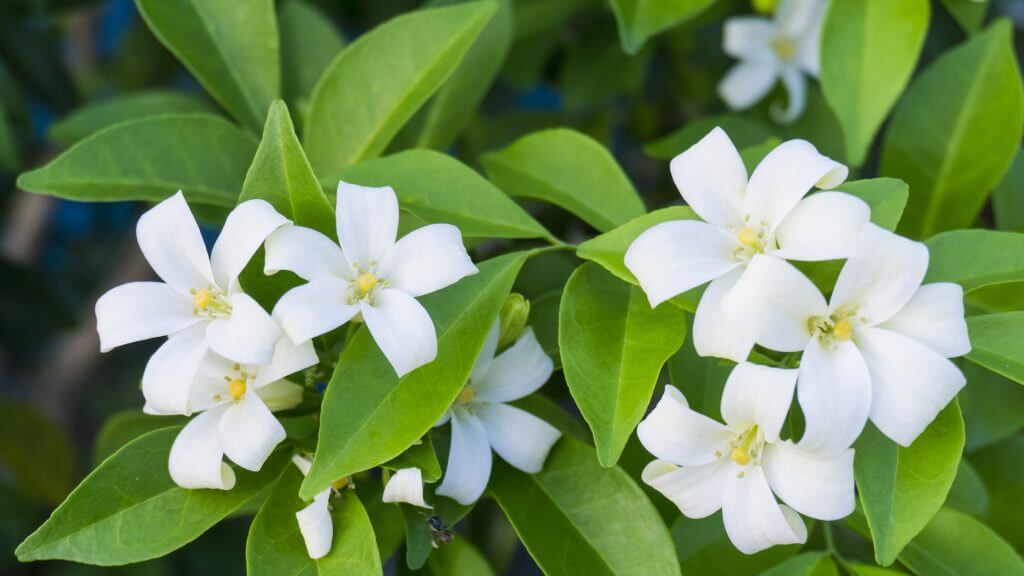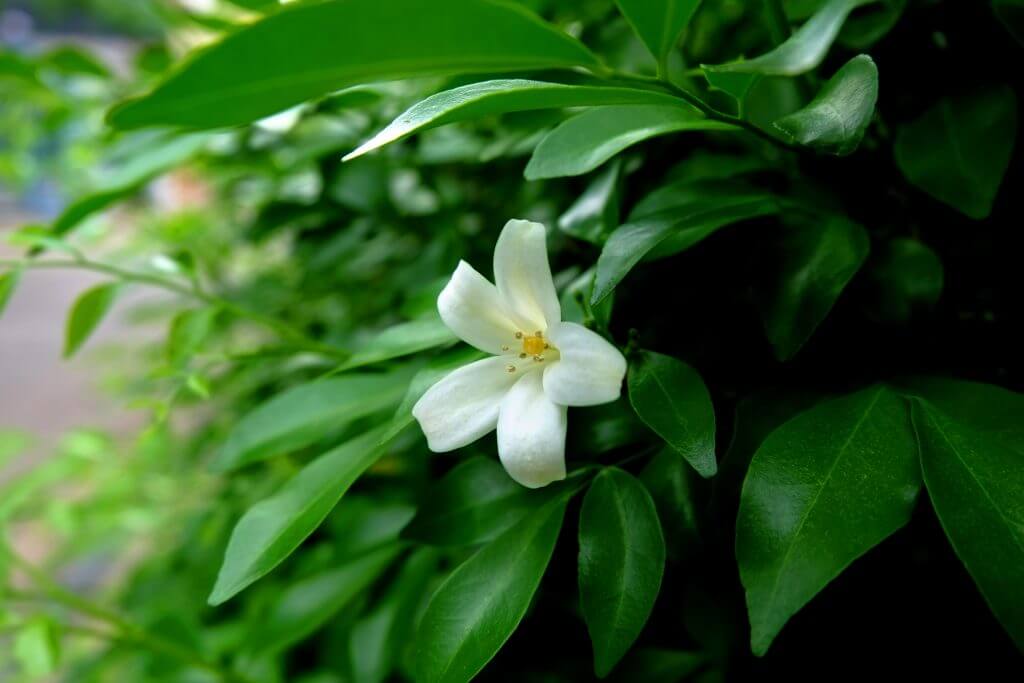The Murraya Hedge is a very popular ornamental hedge and is certainly a favourite of Harwood’s Lawn Care. They are most commonly known for being low maintenance and being a dense dark green hedging plant. It is a favourite of many homeowners for its abundance of white flowers and dense growth. Here’s everything you need to know about growing your own perfect Murraya hedge.
[elementor-template id=”6699″]

Where to buy Murraya Paniculata
If you are looking to buy Murraya Paniculata plants, we suggest you buy your Murraya Paniculata Plants here.
The Basics of the Murraya Hedge
Murraya is also known by “mock orange” or “orange jessamine.” It’s an excellent boundary hedge, as it grows thick. As it grows quickly, it can be cut back to suit any landscape or garden. The Murraya will flower in spring and summer, and it’s extremely easy to grow a healthy Murraya shrub. If you want something low maintenance and fast-growing, a Murraya hedge is an excellent option.
A Murraya hedge, freshly planted, will take three to four years to grow to its full size. Pruning the Murraya regularly will create a dense hedge that can be used as a screen. The Murraya can reach a size of 3 meters, though there are dwarf versions that only reach 1 meter in size. More information about the dwarf varieties here. The Murraya is known by a common name, mock orange because of its fragrant white flowers, which fills the air with a citrus scent when its blossoms bloom. More information about Murraya flowers and their uses here.
Murraya hedges grow best in warm climates like southeastern Queensland, and when they are in warm climates they are extremely hardy and difficult to go wrong with. Many warm neighbourhoods have an abundance of Murraya hedges for this reason, and they’re good for everyone from the beginner to the advanced gardener. Because they are so dense, they are best used for privacy hedges.
Murraya hedges, when first planted, can be small shrubs (such as up to a foot or so), or larger.
The Murraya can also be grown from cuttings. Check out our full guide on growing Murraya from cuttings here.
Planting Your Murraya Hedge
Murraya hedges, botanical name “Murraya Paniculata” should be planted about 30 centimeters to 50 centimeters apart, depending on the desired density. For screens, 30 centimeters may be best, and this also means the screen will form much faster. If you’re not sure about the spacing, check out our full guide on Murraya hedge spacing here.
Murray’s should be planted in a sunny area with well-draining soil. If you have clay soil or other water-retaining soil, consider enriching the soil beforehand. Make sure the area that you have gets enough sun to support the shrubs, or they may not grow as quickly. Check out this guide on when to plant a Murraya.
There are two ways you might get a Murraya hedge: planted or bare root. Either way, you will dig a hole that is twice as wide as the root ball and about 1.5 times as deep, and then you will backfill it with less packed soil. Information about Murraya hedge roots and if they are invasive here. A bare root plant may take some time to awake from dormancy, but either way, your hedge will begin to grow.
The first few months after planting a hedge is often the most critical. You should take care to regularly water and to fertilise it after the hedge has started to take root. Full guide on watering your Murraya here. The best times to plant a hedge are often autumn and spring, though they can also be planted during the summer. If planted in autumn, hedges will often start to take root just before winter dormancy and will emerge much hardier during the spring.


Taking Care of Your Murraya Hedge
Murraya hedges should be pruned in autumn and spring, and fertilised in spring. After pruning, the hedges should be watered and fertilised to encourage the plant to grow. Hedges will flower in spring and summer, during which time they will be extremely showy. Some small amount of pruning can be done once a month to keep the hedge tidy. Check out the full guide on pruning a Murraya hedge here.
Most Murraya hedges should be trimmed to 1.5 to 2 meters rather than being allowed to grow the full 3 meters in height, for an attractive and dense hedge. More about Murraya hedge height here. Many hedges are shaped, such as spherically, but it really depends on the plant type.
When fertilising a Murraya hedge, avoid nitrogen-rich fertilizers; it may encourage the plant to grow too quickly, and its leaves may not be as strong as they should be. More information about fertilising your Murraya hedge here.
Like all shrubs, you should regularly inspect shrubs for general health. If the shrub fails to transplant, you may need to replace it; this can happen with young shrubs. Part of a shrub may begin to die off, which may mean that the roots are not taking well, or that the plant needs more nutrients or water. Leaves will indicate the general health of the shrub. More on transplanting Murraya here.
With a Murraya shrub, the leaves should be deep, healthy green and glossy, and the flowers should be a white to cream color. If the Murraya begins to discolor, it may be an issue with either too much heat or too much water, or it could be pests. Regular pruning will not only keep the shrub’s shape, but also keep it healthy, and will afford the opportunity to check for pests and to cut off any damaged areas.


Common Problems With Murraya Hedges
Murraya hedges don’t do well in areas with cold climates or harsh winters. Instead, frost-hardy plants like Choisyas should be planted. Murraya hedges, in dwarf version, can be planted in large ornamental pots and protected during the cold season, but because they do need a lot of sunshine (and grow fast), it’s usually not advised. More about growing Murray’s in pots here.
As mentioned, Murraya hedges need well-draining soil. One of the major issues with Murraya hedges comes down to too much moisture. If there’s too much water, the soil will not be able to deliver enough oxygen to the plant.
In areas with a significant amount of moisture and rain, Murraya hedges may not be advisable. Murraya hedges shouldn’t be watered frequently, as, in most areas, rainfall is adequate; the exception is just after heavy pruning, when the plant may need more water and nutrients. If leaves are yellowed and dropping, it’s an indication there is too much water.
Apart from this, the Murraya may also become exposed to regular “garden variety” pests. Brown spots on leaves, eaten away patches on leaves, and soft, small sacks around the plant are all indicators that pests may be present and will need to be treated.
Sooty mold can appear on the leaves of a Murraya hedge. This can be caused by whiteflies, aphids or scale. Treat the hedge with neem oil once every 2 weeks. Be careful not to apply the oil when you are expecting hot days or a strong sun as you can run the risk of burning the leaves. To remove the sooty mold, simply spray a dilute mixture of dishwashing liquid and water on the leaves. After 1 hour or so rinse the leaves off with water. This should have your hedge looking green again in no time.
More about common problems with the Murraya hedge here.


Getting Your First Murraya Hedge
Altogether, the Murraya hedge is one of the easiest hedges to plant and maintain and will be an excellent privacy screen or ornamental feature. If you’re in the appropriate environment for a Murraya hedge (warm, with well-drained soil), you can plant one and grow it without too much effort, and within three to four years you’ll have a shrub that blooms every season.
Because the Murraya hedge does not adapt well to the cold, make sure that you have it in a sunny, warm place, and take care to prune it lightly every month, and give it a thorough pruning during its fast growth seasons. With a Murraya hedge, it’s difficult to go wrong.
[elementor-template id=”6009″]
[elementor-template id=”6387″]
